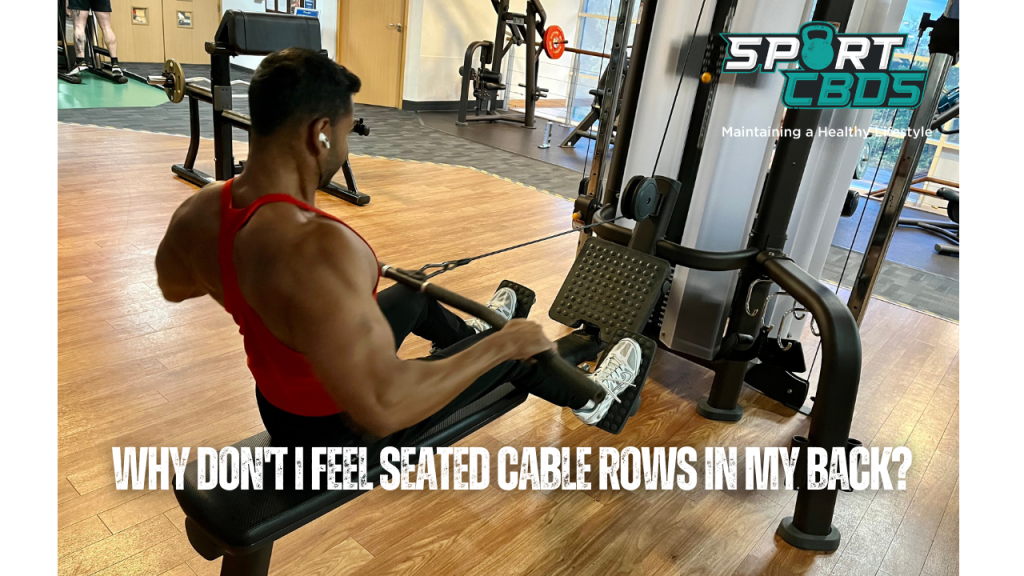
Why Don’t I Feel Seated Cable Rows in My Back? Tips for Better Back Engagement
Seated cable rows are a staple in many workout routines, designed to target the back muscles effectively. However, a common issue that many gym-goers face is not feeling the intended muscle engagement in the back during this exercise. Instead, they often feel the strain in their arms or shoulders, leading to ineffective workouts and missed opportunities for muscle growth in the back.
Understanding proper form and muscle engagement is crucial for any exercise, but it becomes even more important for complex movements like seated cable rows. Incorrect form not only diminishes the effectiveness of the exercise but also increases the risk of injury.
This article aims to delve into the reasons why you might not be feeling seated cable rows in your back and how to correct this. We will explore the anatomy involved in a seated cable row, common mistakes that lead to improper muscle engagement, and tips for achieving the perfect form. By the end of this article, you’ll have a comprehensive understanding of how to make the most out of your seated cable rows.
Why Don’t I Feel Seated Cable Rows in My Back?
If you’re struggling to feel seated cable rows in your back, the issue often lies in improper form and muscle engagement. Common mistakes include incorrect grip and hand positioning, which can shift the focus to your arms instead of your back. Overuse of arm muscles, lack of scapular retraction, and poor posture can also contribute to this problem. Understanding the anatomy of the targeted back muscles—Latissimus Dorsi, Rhomboids, and Traps—can help you visualize and engage them more effectively. Enhancing your mind-muscle connection through techniques like visualization can also improve muscle engagement. Therefore, focusing on proper form and being mindful of the muscles you’re targeting can help you feel the exercise where you’re supposed to: in your back.
The Anatomy of a Seated Cable Row
Muscles Targeted: Latissimus Dorsi, Rhomboids, and Traps
The primary muscles targeted in a seated cable row are the Latissimus Dorsi, commonly known as the “lats,” the Rhomboids, and the Trapezius or “traps.” These muscles are the powerhouses for pulling movements and are essential for a strong and well-defined back.
Role of Secondary Muscles: Biceps and Forearms
While the back muscles are the primary focus, the biceps and forearms also play a role as secondary muscles. They assist in the pulling motion but should not be the main drivers of the movement. Over-reliance on these secondary muscles is one reason you might not feel the exercise in your back.
Importance of Understanding Anatomy for Effective Workouts
Understanding the anatomy of the muscles involved in the seated cable row is crucial for several reasons. First, it helps you visualize the muscles you should be engaging, aiding in a better mind-muscle connection. Second, it allows you to identify which muscles you’re actually using, helping you correct your form if you’re not feeling the exercise where you should be. Lastly, a good anatomical understanding enables you to modify the exercise to better target specific muscles, making your workouts more effective.
By understanding the roles of both primary and secondary muscles in seated cable rows, you can better focus your mind and energy on engaging the right muscles. This not only makes the exercise more effective but also reduces the risk of injury due to improper form.
Common Mistakes and Why You Don’t Feel It in Your Back
Incorrect Grip and Hand Positioning
One of the most common mistakes that lead to not feeling seated cable rows in your back is incorrect grip and hand positioning. Many people grip the handle too tightly or use a full grip, which engages the forearms and biceps more than necessary. This shifts the focus away from the back muscles, making the exercise less effective for its intended purpose.
Overuse of Arm Muscles
Another prevalent issue is the overuse of arm muscles, particularly the biceps. When you pull the cable towards you, the biceps naturally want to do most of the work. This is especially true if you’re using a weight that’s too heavy for your back muscles to handle. The result is that you feel the burn in your arms, not your back.
Lack of Scapular Retraction
Scapular retraction, or pulling your shoulder blades together, is a crucial part of effectively engaging your back muscles. Many people neglect this aspect, leading to a lack of engagement in the targeted back muscles. Without scapular retraction, you’re essentially just going through the motions without activating the muscles you’re aiming to work on.
Incorrect Posture and Back Alignment
Last but not least, incorrect posture and back alignment can significantly affect how you feel the exercise in your back. Slouching or rounding your back not only disengages the targeted muscles but also puts you at risk for injury. Proper alignment involves keeping a straight back and engaging your core throughout the movement.
By avoiding these common mistakes, you can ensure that you’re effectively targeting your back muscles during seated cable rows. Understanding what not to do is just as important as knowing the correct form, as it helps you become more conscious of your movements and muscle engagement.
Related: Unlock Your Potential: Why Am I Having Trouble Activating My Lats?
Tips for Proper Form
The Importance of Grip: Thumbless vs. Full Grip
The grip you use can significantly influence which muscles are engaged during the exercise. A thumbless grip, often referred to as a “hook grip,” can help you focus more on your back muscles by minimizing forearm and bicep engagement. On the other hand, a full grip tends to engage the arms more, which is not what you want for this specific exercise.
Scapular Retraction: What It Is and How to Do It
Scapular retraction involves pulling your shoulder blades towards each other, creating a “pinching” sensation in your upper back. This is crucial for engaging the targeted back muscles effectively. To achieve this, focus on pulling the shoulder blades together as you pull the cable towards you.
Elbow Positioning and Its Role
The position of your elbows can also impact which muscles are engaged. Keeping your elbows close to your body targets the lats more effectively, while flaring them out engages the upper traps and rhomboids. Experiment with different elbow positions to find what works best for you.
The Role of the Chest: Keeping It Up and Out
Keeping your chest up and out during the exercise helps maintain proper back alignment and encourages better muscle engagement. It also prevents you from slouching, which can disengage the back muscles and lead to ineffective workouts.
By following these tips for proper form, you can maximize the effectiveness of your seated cable rows and ensure that you’re engaging the right muscles. Proper form is not just about avoiding injury; it’s about making every rep count.
Mind-Muscle Connection
What is the Mind-Muscle Connection?
The mind-muscle connection is a concept that refers to the focus and awareness you bring to the muscle you are working during an exercise. It’s the ability to mentally “tune into” a specific muscle and make it work harder, thereby maximizing the effectiveness of each rep.
How to Improve It for Better Muscle Engagement
Improving your mind-muscle connection starts with slowing down your movements. Rushing through reps often leads to sloppy form and less effective muscle engagement. Take time to feel each phase of the movement, from the stretch to the contraction. Breathing also plays a crucial role; inhale during the easier part of the movement and exhale during the exertion phase.
Visualization Techniques
Visualization can be a powerful tool for enhancing your mind-muscle connection. Before starting the exercise, close your eyes and visualize the targeted muscles contracting and relaxing. Imagine a strong, cord-like connection between your mind and the muscle, and use this mental imagery to guide your physical movement.
Related: Why Can’t I Do Pull-Ups Anymore Even If I Am Much Stronger? A Deep Dive into Strength Training
Seated Rows and Grip Strength
Improving your grip strength can significantly enhance your ability to feel seated cable rows in your back. A stronger grip allows for better control of the cable, enabling you to focus more on engaging your back muscles rather than relying on your arms.
This can be particularly beneficial for achieving proper scapular retraction, a key element in targeting the back muscles effectively. A study published by Cleveland Clinic supports the importance of grip strength in enhancing overall muscle engagement in resistance exercises.
For those looking to improve their grip strength, specialized equipment like grip strengtheners available on Amazon or CBD products designed for athletes at Sport CBDs can be helpful resources.
FAQs
Why can’t I feel my back in cable rows?
If you can’t feel your back during cable rows, it’s likely due to incorrect form or overuse of secondary muscles like the arms.
How do you feel back on seated cable rows?
To feel your back during seated cable rows, focus on scapular retraction and proper grip. Slow down your reps and concentrate on the targeted muscles.
Does seated cable row work back?
Yes, seated cable rows are designed to target the back muscles, particularly the lats, rhomboids, and traps.
Where should you feel rows?
You should feel rows in your upper and middle back, specifically in the lats, rhomboids, and traps.
Why do I feel it in my arms and not my back?
Feeling the exercise in your arms rather than your back usually indicates overuse of the arm muscles and improper form.
How important is grip in seated cable rows?
Grip is crucial in seated cable rows. A thumbless or “hook” grip can help you focus more on your back muscles.
What are some alternative exercises if I can’t feel it in my back?
If you’re struggling to feel seated cable rows in your back, consider trying alternative exercises like barbell rows, dumbbell rows, or pull-ups to target the back muscles effectively.
Final Thoughts…
In summary, the effectiveness of seated cable rows—or any exercise, for that matter—largely depends on proper form and muscle engagement. From understanding the anatomy of the back muscles to avoiding common mistakes, each aspect plays a crucial role in how you feel the exercise.
The mind-muscle connection is not just a buzzword; it’s a fundamental principle that can make or break your workouts.
If you’ve been struggling to feel seated cable rows in your back, take this as an opportunity to revisit your form and focus. Remember, the goal is not just to lift the weight; it’s to work the muscle. So, slow down, focus, and make every rep count. Your back will thank you for it.
Why don’t you feel seated cable rows in your back? Have our tips been beneficial to your training? We’d love to hear your feedback, so please share your thoughts in the comments section below.
If you’re a sports enthusiast who utilizes CBD for optimal recovery after intense workouts, then you’ve found your tribe. Welcome to Sport CBDs, where we push our limits in training and prioritize recovery in the most effective way possible.
We regularly share workout routines on our YouTube channel and offer a range of health and fitness products designed to give you that competitive edge.
Why not explore the high-quality CBD products we proudly feature on our site? Visit the Sport CBDs Store by clicking here. In addition to CBD, we also offer an array of fitness clothing and yoga accessories to complement your active lifestyle.
Until next time, we wish you the best in your fitness journey. Remember, your progress is our passion. Stay strong and keep pushing!


